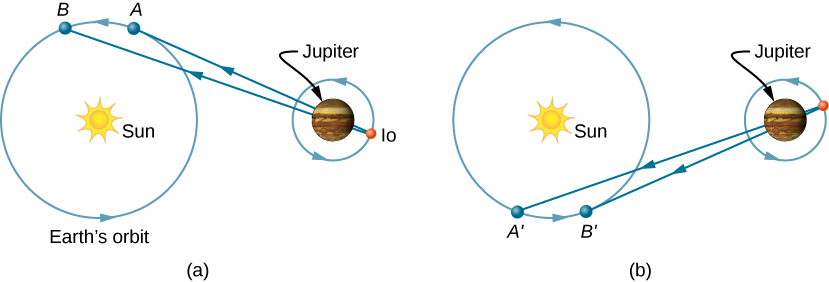| << Chapter < Page | Chapter >> Page > |
The speed of light in a vacuum c is one of the fundamental constants of physics. As you will see when you reach Relativity , it is a central concept in Einstein’s theory of relativity. As the accuracy of the measurements of the speed of light improved, it was found that different observers, even those moving at large velocities with respect to each other, measure the same value for the speed of light. However, the speed of light does vary in a precise manner with the material it traverses. These facts have far-reaching implications, as we will see in later chapters.
The first measurement of the speed of light was made by the Danish astronomer Ole Roemer (1644–1710) in 1675. He studied the orbit of Io, one of the four large moons of Jupiter, and found that it had a period of revolution of 42.5 h around Jupiter. He also discovered that this value fluctuated by a few seconds, depending on the position of Earth in its orbit around the Sun. Roemer realized that this fluctuation was due to the finite speed of light and could be used to determine c .
Roemer found the period of revolution of Io by measuring the time interval between successive eclipses by Jupiter. [link] (a) shows the planetary configurations when such a measurement is made from Earth in the part of its orbit where it is receding from Jupiter. When Earth is at point A , Earth, Jupiter, and Io are aligned. The next time this alignment occurs, Earth is at point B , and the light carrying that information to Earth must travel to that point. Since B is farther from Jupiter than A , light takes more time to reach Earth when Earth is at B . Now imagine it is about 6 months later, and the planets are arranged as in part (b) of the figure. The measurement of Io’s period begins with Earth at point and Io eclipsed by Jupiter. The next eclipse then occurs when Earth is at point , to which the light carrying the information of this eclipse must travel. Since is closer to Jupiter than , light takes less time to reach Earth when it is at . This time interval between the successive eclipses of Io seen at and is therefore less than the time interval between the eclipses seen at A and B . By measuring the difference in these time intervals and with appropriate knowledge of the distance between Jupiter and Earth, Roemer calculated that the speed of light was which is 33% below the value accepted today.

The first successful terrestrial measurement of the speed of light was made by Armand Fizeau (1819–1896) in 1849. He placed a toothed wheel that could be rotated very rapidly on one hilltop and a mirror on a second hilltop 8 km away ( [link] ). An intense light source was placed behind the wheel, so that when the wheel rotated, it chopped the light beam into a succession of pulses. The speed of the wheel was then adjusted until no light returned to the observer located behind the wheel. This could only happen if the wheel rotated through an angle corresponding to a displacement of teeth, while the pulses traveled down to the mirror and back. Knowing the rotational speed of the wheel, the number of teeth on the wheel, and the distance to the mirror, Fizeau determined the speed of light to be which is only 5% too high.

Notification Switch
Would you like to follow the 'University physics volume 3' conversation and receive update notifications?